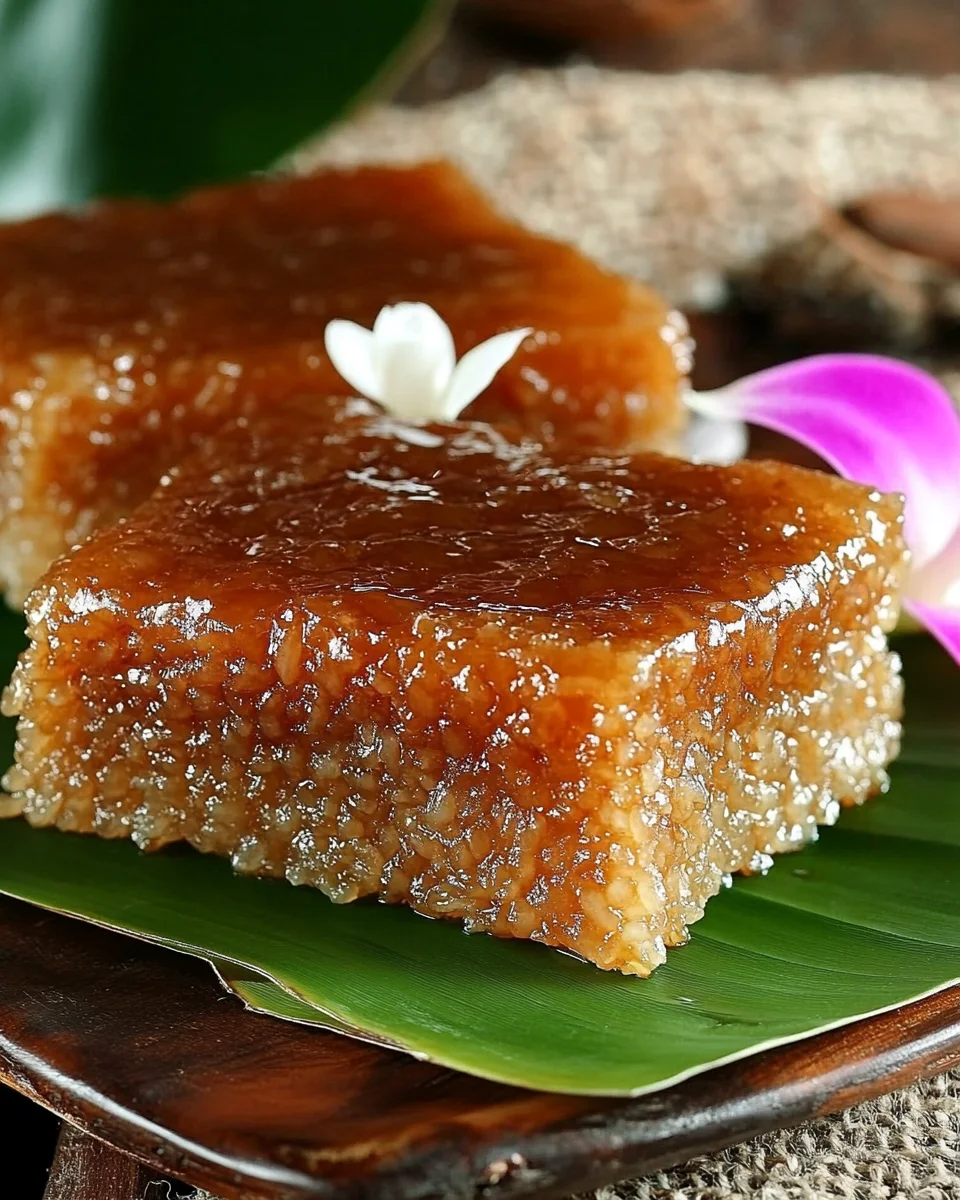Biko is a beloved Filipino delicacy that holds a special place in the hearts of many. With its perfectly chewy texture, rich coconut flavor, and irresistible caramel topping, this classic kakanin (rice cake) is a staple at celebrations, family gatherings, and holiday feasts. Though simple in ingredients, Biko carries generations of culinary heritage, reflecting the Filipino love for sweet and satisfying treats.
In this article, we will explore the origins of Biko, its cultural significance, variations across regions, expert tips for the perfect texture, and frequently asked questions that will help you master this delightful dessert.
A Taste of History: The Origins of Biko
Like many traditional Filipino dishes, Biko has deep roots in the country’s indigenous culture. It belongs to a category of rice-based delicacies known as kakanin, a term derived from the Filipino word “kanin” (meaning rice). Before the arrival of Spanish colonizers, early Filipinos already had a diet rich in rice, coconuts, and sugarcane—all essential ingredients for Biko.
Over time, this humble sticky rice cake became an integral part of Filipino celebrations. It is commonly served during fiestas, birthdays, reunions, and even New Year’s Eve as a symbol of prosperity and togetherness. The sticky consistency of Biko is often associated with strong family bonds, making it more than just a dessert—it is a reminder of home, love, and tradition.
Why Filipinos Love Biko
1. Simple Yet Satisfying
Biko requires only a few key ingredients: glutinous rice, coconut milk, and brown sugar. Despite its simplicity, the flavors come together beautifully, offering a perfect balance of sweetness and creaminess.
2. A Dessert for All Occasions
Whether it’s a grand fiesta, a humble family merienda (afternoon snack), or a church gathering, Biko is always welcome. It is often displayed in a bilao—a round woven bamboo tray lined with banana leaves—adding to its rustic charm.
3. Comfort Food with a Nostalgic Touch
Many Filipinos associate Biko with childhood memories, recalling the comforting aroma of coconut and caramelized sugar filling their homes. Passed down from one generation to the next, this dish holds sentimental value for many families.
Biko Variations Across the Philippines
Biko may have a standard base of sticky rice and coconut, but different regions in the Philippines have their own unique versions:
1. Bibingkang Malagkit
This version of Biko is baked and often has a thicker layer of caramel topping. The texture is slightly firmer, and some recipes add butter for an extra indulgent finish.
2. Sinukmani
In the Southern Tagalog region, Biko is commonly known as Sinukmani. It is usually topped with latik (toasted coconut curds) instead of syrup and is sometimes made with additional ingredients like peanuts or jackfruit.
3. Biko with Langka
Some versions incorporate sweetened langka (jackfruit) into the mix, adding a fruity aroma and subtle tartness that pairs well with the richness of the coconut.
4. Ube Biko
A modern twist on this traditional dish, Ube Biko incorporates ube halaya (purple yam jam), giving it a vibrant purple color and a distinct, mildly nutty sweetness.
5. Pandan-Infused Biko
For a fragrant variation, some cooks add pandan leaves while cooking the rice, lending a subtle floral aroma that enhances the overall taste.
Secrets to Achieving the Perfect Biko
1. Choosing the Right Rice
The key to a chewy yet firm Biko is using glutinous rice (also known as sticky rice or “malagkit”). Regular rice will not yield the same texture, so it’s essential to use the correct variety.
2. Cooking the Rice Correctly
One of the most common mistakes when making Biko is fully cooking the rice before mixing it with the caramel sauce. Instead, it should be only partially cooked, allowing it to absorb the latik syrup gradually.
3. Balancing the Sweetness
Dark brown sugar or muscovado is preferred for a deep, rich caramel flavor. If you prefer a lighter taste, you can adjust the sugar content to suit your preference.
4. Achieving the Perfect Caramelized Topping
For that signature glossy, golden-brown finish, let the latik syrup cook down until it thickens before spreading it over the rice. Baking it in the oven helps set the topping, giving it a firmer consistency.
5. Enhancing Flavor with Aromatics
Adding pandan leaves or a touch of vanilla to the coconut mixture elevates the flavor profile, making your Biko even more fragrant and enjoyable.
Gather Your Treasures: Ingredients
For the Sticky Rice Base:
- 2 cups glutinous rice, washed and drained
- 1 cup canned coconut milk
- 1 cup water
- 2 pieces pandan leaves
For the Golden Caramel Topping (Latik Syrup):
- 2 cups canned coconut milk
- 1 cup dark brown sugar, packed
- 1 teaspoon vanilla extract (optional)
- Vegetable or coconut oil for greasing the pan
The Art of Making Biko: Directions
- Prepare the Canvas: Generously grease an 8×8-inch baking pan and set it aside.
- Infuse the Sticky Rice: In a large pot over medium heat, combine 1 cup of coconut milk and 1 cup of water. Add the washed glutinous rice and pandan leaves. Bring to a gentle simmer, then lower the heat, cover, and cook until the liquid is absorbed. The rice should be almost cooked but not fully softened. If needed, add a little more water (start with ¼ cup).
- Create the Caramel Bliss: While the rice cooks, prepare the latik syrup. In a separate large pan, combine 2 cups of coconut milk and 1 cup of dark brown sugar. Stir constantly over medium heat until it thickens and darkens into a rich caramel syrup. Add vanilla extract if desired. Reduce heat to low.
- Marry the Flavors: Reserve ½ cup of the latik syrup for the topping. Remove the pandan leaves from the cooked rice, then fold the sticky rice into the remaining latik syrup. Stir gently until the rice fully absorbs the syrup without becoming mushy. The grains should remain visible with some slightly white portions.
- Shape and Set: Transfer the mixture into the greased baking pan and spread it evenly. Pour the reserved latik syrup on top, smoothing it out for an even caramel glaze.
- Bake to Perfection: Place the pan in a preheated oven at 350°F (180°C) and bake for 20–30 minutes or until the latik topping turns bubbly and thick.
- Cool, Slice, and Serve: Let the biko cool before cutting into squares. Enjoy this delightful treat!
Nutritional Goldmine: What’s Inside Each Serving?
- Calories: 455 kcal
- Carbohydrates: 66g
- Protein: 5g
- Fat: 20g (with 18g saturated fat)
- Fiber: 3g
- Sugar: 28g
- Sodium: 24mg
- Potassium: 291mg
- Vitamin C: 2mg
- Calcium: 41mg
- Iron: 2mg
Indulge in this rich and chewy Filipino delicacy, perfect for celebrations or a simple sweet craving.
Frequently Asked Questions About Biko
1. Can I make Biko without an oven?
Yes! While some recipes call for baking to set the latik topping, traditional Biko is often just cooked on the stovetop. Simply let it cool at room temperature before serving.
2. What is the best way to store Biko?
Biko is best enjoyed fresh, but if you have leftovers, store them in an airtight container at room temperature for up to 24 hours. If refrigerating, warm it up slightly before eating, as cold Biko tends to harden.
3. Can I use a rice cooker to cook the glutinous rice?
Yes, but be careful not to overcook it. Cook the rice with a mix of water and coconut milk on the “cook” setting, then proceed with mixing it into the latik syrup.
4. Why is my Biko too soft or mushy?
This usually happens when too much liquid is used while cooking the rice or if it is overmixed when combined with the syrup. To fix this, let it set longer before serving.
5. How do I make my Biko less sweet?
You can reduce the amount of brown sugar or use a lighter sugar variety. Some people also balance the sweetness by topping their Biko with toasted coconut flakes or crushed peanuts.
Conclusion: A Timeless Filipino Dessert Worth Sharing
Biko is more than just a sweet treat; it is a dish filled with history, meaning, and tradition. Whether you enjoy it at a family gathering, serve it at a party, or make it as a nostalgic reminder of home, Biko remains a cherished part of Filipino cuisine. Its simplicity, versatility, and comforting flavors make it a dessert that continues to be loved across generations.
So the next time you crave something sweet and satisfying, consider making a batch of Biko—an enduring symbol of warmth, celebration, and the rich culinary heritage of the Philippines.

Biko: The Sweet, Sticky Filipino Rice Cake Steeped in Tradition
- Total Time: 50 minutes
- Yield: 8 servings
Description
Indulge in the rich, chewy goodness of Biko, a traditional Filipino sticky rice cake made with glutinous rice, creamy coconut milk, and a luscious caramelized topping. This beloved kakanin is a staple in Filipino gatherings, offering a perfect balance of sweetness and texture. Whether for special celebrations or a simple craving, Biko is a heartwarming treat that brings the taste of home with every bite.
Ingredients
For the Sticky Rice Base:
2 cups glutinous rice, washed and drained
1 cup canned coconut milk
1 cup water
2 pieces pandan leaves
For the Golden Caramel Topping (Latik Syrup):
2 cups canned coconut milk
1 cup dark brown sugar, packed1 teaspoon vanilla extract (optional)
Vegetable or coconut oil for greasing the pan
Instructions
-
Prepare the Pan: Grease an 8×8-inch baking pan and set aside.
-
Cook the Sticky Rice: In a large pot over medium heat, combine 1 cup of coconut milk, 1 cup of water, and pandan leaves. Add the washed glutinous rice, bring to a gentle simmer, then reduce heat and cover. Cook until the liquid is absorbed, stirring occasionally. Add ¼ cup of water if needed.
-
Make the Latik Syrup: In a separate pan, combine 2 cups of coconut milk and 1 cup of dark brown sugar. Stir over medium heat until it thickens into a caramel-like syrup. Add vanilla extract if using, then reduce heat to low.
-
Combine the Rice and Syrup: Remove the pandan leaves from the cooked rice. Reserve ½ cup of the latik syrup for topping, then fold the sticky rice into the remaining syrup. Stir until fully coated but not mushy.
-
Transfer and Spread: Pour the mixture into the greased baking pan, spreading evenly. Top with the reserved latik syrup for a smooth caramelized finish.
-
Bake: Preheat the oven to 350°F (180°C) and bake for 20–30 minutes until the topping thickens and bubbles.
-
Cool and Serve: Let the Biko cool before slicing into squares. Enjoy!
Notes
-
If you prefer a softer texture, add an extra ¼ cup of coconut milk to the rice while cooking.
-
Biko can be stored in an airtight container at room temperature for up to 2 days or refrigerated for up to a week. Reheat gently before serving.
-
For added flavor, sprinkle toasted coconut flakes or latik (coconut curds) on top before serving.
- Prep Time: 10 minutes
- Cook Time: 40 minutes
- Category: Dessert
- Method: Baking
- Cuisine: Filipino





